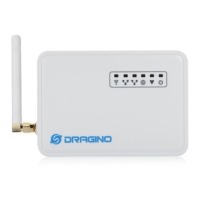www.dragino.com
LoRa Gateway User Manual ---Update:2017-02-21 35 / 44
9.3 Multiple Nodes examples
The example shows how the gateway can handle multiple nodes up to several hundreds. The
example can be found at IDE --> File --> Examples --> Dragino --> LoRa --> Concurrent
How it works:
This concurrent client sketch is working together with the concurrent gateway sketch. Before
using this sketch, please use the write_client_id sketch to write a client ID in the EEPROM.
Client ID is the unique id for each client in the LoRa network. write_gateway_id to gateway is not
necessary, if not write, gateway id will be 0XFF.
When the client boot, it will keep listening for the broadcast message from LoRa Gateway.
When the gateway sketch boot, it will broadcast a message to set up a LoRa Network. If it
gets broadcast message, client will send a join request message to gateway, when the join
request message arrive to gateway, the gateway will send back a join-ack message with
client id and add this client to the LoRa Network.
If the client gets its join-ack message for its join request, it will enter the mode to listen
the data-request message from gateway. In this mode, if client get a data-request
message for this client it will send back a data message to the gateway.
After client in data_request listening mode, if it has not receive any message from
gateway in a timeout, it will go back to the network set up mode to listen the broadcast
message.
Gateway will refresh the LoRa network periodically for adding new client or remove
unreachable client.
This example using the polling method between LoRa node and Gateway, it will minimize the
LoRa packets transfer on the air and avoid congestion. It is suitable for a not real time LoRa work.
Performance test in a room with 100 nodes and 1 gateway shows:
a) Gateway require about 1.5 minutes to set up this 100 nodes Network
b) Gateway takes about 2 minutes to do polling for these 100 nodes.
User can adjust the timing in the sketch from case by case.

